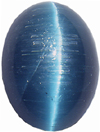CHATOYANT
GEMSTONES
Although "cat's-eye"
by itself usually refers to
cat's-eye chrysoberyl, there
are approximately fifty species
of gemstones that may exhibit
chatoyancy, including emerald,
tourmaline, quartz, apatite,
and zircon. If one of these
happens to contain needle-like
inclusions oriented in a single
direction, and is cut as a cabochon,
light shined on it will be concentrated
and the chatoyancy will appear.
The proper way to refer to these
gemstones is to prefix their
names with the words "cat's-eye". |
 |
 |
Weight
: 1.92 ct
Size (mm) : L 6.5 x W
6.4 x
D 5.73
US $12,000 |
Cat's-Eye Emerald
There are some fine-quality
Cat's-eye emeralds among the
emeralds from Brazil. Those
with deep color and well-defined
chatoyancy are very expensive,
and may command prices in excess
of $20,000 for a five-carat
stone. Cat's-eye emeralds from
Colombia have also begun to
appear on the market. The piece
shown here is of Brazilian origin. |
|
|
Cat's-Eye
Tourmaline
This material is mined in considerable
quantities, but it usually does not
have the high transparency and well-defined
chatoyancy required for gem quality.
Low-quality material is opaque, but
tends to have distinct chatoyancy
due to an abundance of inclusions.
In an unfortunate tradeoff, the transparency
improves as the number of inclusions
decreases, but the chatoyancy also
becomes weaker and weaker. The most
common colors for cat's-eye tourmalines
are green and blue. |
Weight
: 4.79 ct
Size (mm) : L 12.1 x W 9.0x
D 5.57
US $600 |
 |
 |
 |
 |
Weight
: 10.15 ct
Size (mm) :Diameter 14.8 x D7.04
US $50 |
Tiger's-Eye
Tiger's-eye is a brown variety of
quartz that exhibits chatoyancy. Hawk's-eye
is a similar variety of chatoyant
quartz that is a blue to green color.
Tiger's-eye is mined in South Africa
in extremely large quantities, and
is inexpensive. |
|
 |
JUDGING QUALITY
Key to the quality of a cat's-eye
chrysoberyl are (1) the appearance
of the chatoyant effect, (2)
an optimum
color and transparency, and (3) its
overall shape and form. It
goes without
saying that any imperfection large
enough to detract from the
gemstone’s
beauty will lower its quality and
diminish its value.
Fine-quality
material
displays a single sharp line of light
precisely in the middle of
the cabochon
when illuminated directly from above,
but under indirect lighting
the chatoyant
band will be diffused. The chatoyant
band will also appear weaker
in more
transparent stones. Simply put, the
band becomes less visible as
the number
of needle-like inclusions decreases.
Even if the cat's-eye is sharp,
however,
an opaque stone is not considered
fine material. Finally, a chatoyant
band that extends completely
along
the vertical direction of the cabochon
is most desirable.
The base
of a cat's-eye
commonly has a rough finish similar
to etched glass to enhance
the chatoyant
effect. There may be remnants of
the rough crystal's surface
on the bottom,
but this is not a problem. In gem-quality
material, the bottom of the
stone
must not be so deep that it would
interfere with setting the
stone in
jewelry.
The ideal color for a cat's-eye
chrysoberyl is the "milk-and-honey" color
shown in the photograph on
the previous page, but most
stones show
a lemon yellow, greenish yellow,
or dark brown color instead
of a honey
color. Cat's-eyes from the state
of Orissa in India are often
well-shaped
stones with a greenish color, but
because production is high,
prices
are low. The samples shown in 1-C
and 1-D of the quality scale
are from
Orissa, while the remaining spaces
show stones from the current
major
producing countries of Sri Lanka
and Brazil.
|
|